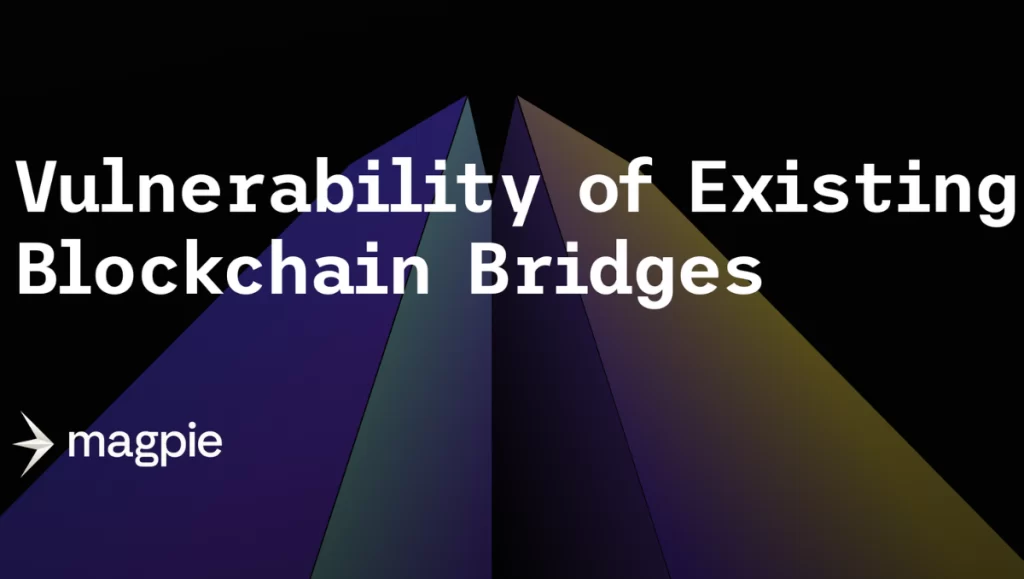The Problem With Existing Cross-Chain Bridges

The post The Problem With Existing Cross-Chain Bridges appeared first on Coinpedia – Fintech & Cryptocurreny News Media| Crypto Guide
In case you’ve not dealt with DeFi bridges, a blockchain bridge is a third-party virtual infrastructure that connects two sovereign blockchain networks that enables users to swap assets and send cryptocurrency to one another.
Also known as cross-chain bridges, these represent some of the most important interoperability solutions in the blockchain space, enabling closed-off blockchain protocols to communicate with one another and digital assets to cross the borders of their native chains.
As always, revolutionary new software comes with new challenges, especially when it comes to cross-chain applications. Undoubtedly there is a growing issue with existing blockchain bridges, which industry experts refer to as the billion-dollar bridge problem.
The Billion-Dollar Bridge Problem
The warm days of August in 2021 have also seen the biggest cryptocurrency heist up to that date, as $600 million worth of digital assets were stolen from the Poly Network, which is a global cross-chain protocol building Web3 interoperability. In a twisted turn of events, the hacker was later offered a job at Poly Network after returning all the stolen funds, alleging that his intention was merely to demonstrate the vulnerability of cross-chain bridges.
Yet the relief among crypto enthusiasts was short-lived, as March 2022 brought the largest crypto theft in history, which resulted in $625 million worth of cryptocurrency stolen from the Ronin Bridge — a cross-chain bridge used by play-to-earn game Axie Infinity that enables asset transfers between the Ethereum and Ronin networks.
According to Ronin’s post-mortem post, the attacker managed to gain control of 5 out of the 9 validator nodes used by Sky Mavis’s Ronin bridge, which are needed to sign and validate transactions.
Factoring in the $325 million Wormhole exploit that happened about two months prior to the Ronin attack, hackers have stolen over $1 billion worth of cryptocurrency from blockchain bridges within a single year. Today, this is known as blockchain’s billion-dollar bridge problem.
But why do blockchain bridges keep getting hacked in the first place? And more importantly, what is the issue with existing cross-chain bridges?
One of the problems is that cross-chain bridges are highly intricate solutions that handle many complex requests and hold large amounts of cryptocurrency. And unlike blockchain networks, cross-chain bridges are third-party infrastructures that aren’t inherently decentralized and secure.
Not to mention that most cross-chain bridges are offering support for multiple blockchains and each additional chain increases the chances of an error or vulnerability appearing within the code. Or as Ronghui Gu, founder of blockchain security firm CertiK puts it: “If you’re trying to create a bridge between N different cryptocurrencies, the complexity of that is N squared,†— which means N more chances for bugs to creep in.â€
Another major issue with centralized bridges like Wrapped Bitcoin is that all the assets are stored on the bridge, under the control of a single custodian known as BitGo — which creates a central point of failure for the entire bridge. Since blockchain protocols within themselves have no central point of failure, hackers made cross-chain bridges the Achilles heel of the industry, due to being easier to attack.
As most bridges are off-chain solutions, they don’t benefit from the decentralization and immutability of the blockchain ledger. While most blockchain networks are written using entirely different programming languages, it’s difficult to bridge them. In the worst-case scenario, a subpar cross-chain bridge could also spread the vulnerabilities of one blockchain to another network, and vice versa.
To sum it up, most existing cross-chain bridges are exceedingly centralized and carry out complicated requests with countless moving parts, making it difficult to create a bulletproof solution. Additionally, central cross-chain bridges hold large amounts of cryptocurrency in the control of a central custodian. Wrapped Bitcoin holds over 273,302 BTC worth over $8.1 billion at press time, all in the custody of BitGo — making for a single point of failure that’s hard to ignore for actors with malicious intent.
Solving the Blockchain Bridge Problem
While the advantages and cross-chain interoperability created by blockchain bridges are undeniable, existing blockchain bridges must strive to become safer, more efficient, and more decentralized.
Decentralized, non-custodial, chain-agnostic bridges will likely gain more prominence, especially for DeFi investors who don’t feel comfortable trusting their tokens with a central custodian, which defeats the purpose of decentralization.
Non-custodial cross-chain aggregation protocols like Magpie, bringing the functionality of a bridge while not being one, have started to emerge as safer alternatives, where there is no central custodian taking control of user assets, hence no single point of failure. Instead, Magpie leverages cross-chain bridges as a messaging layer to communicate asset swaps, without ever holding user assets locked in a vulnerable cross-chain bridge.
As a result, Magpie users will get their requested assets from a chain-specific stablecoin or native single-asset pools (ex. ETH, AVAX, MATIC), which benefits from the security and immutability of the decentralized ledger. Similar non-custodial solutions will likely emerge in the future, putting an end to blockchain’s billion-dollar bridge problem. As the industry is becoming increasingly decentralized, existing cross-chain bridges will have to follow suit, in order to create more security for crypto holders.